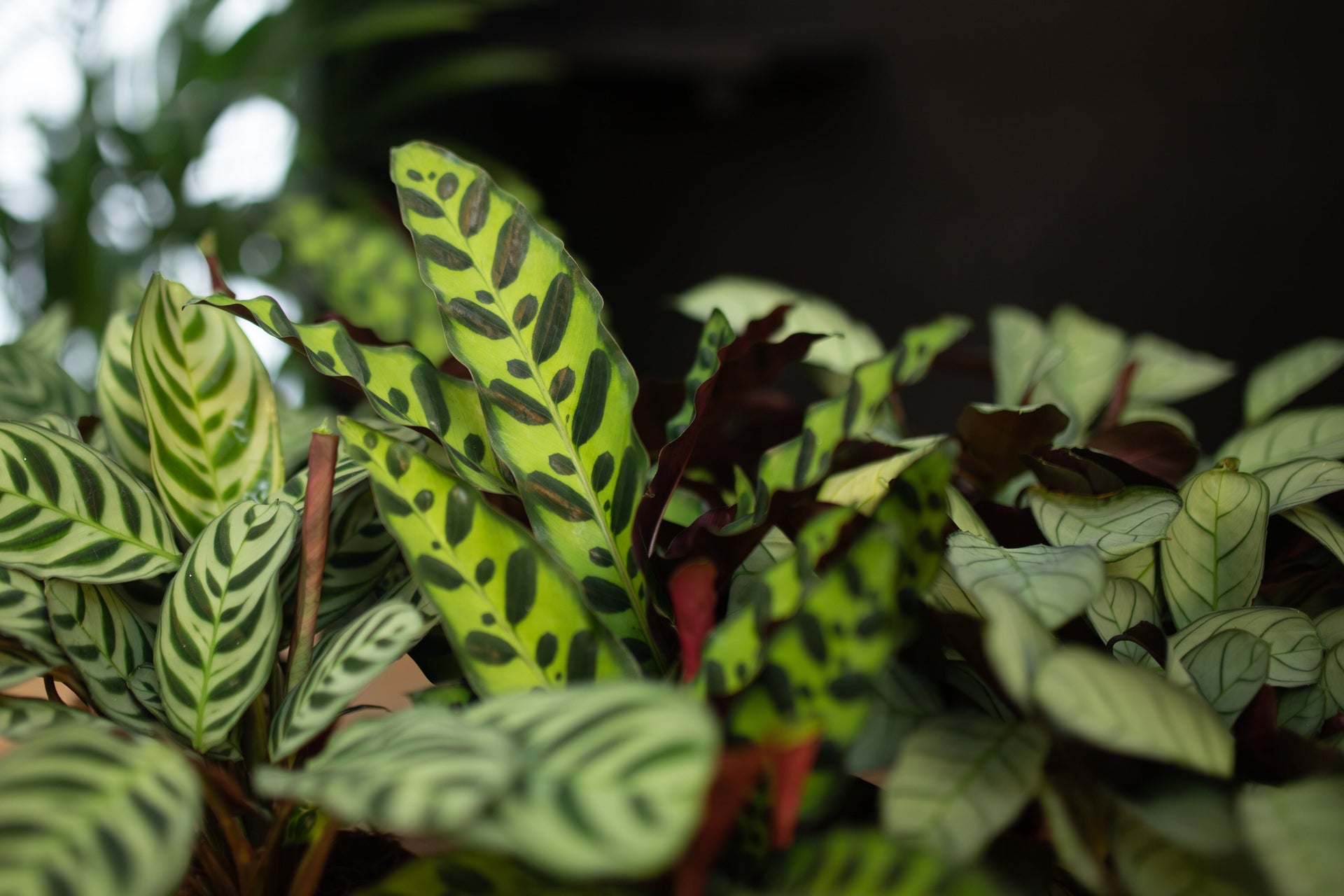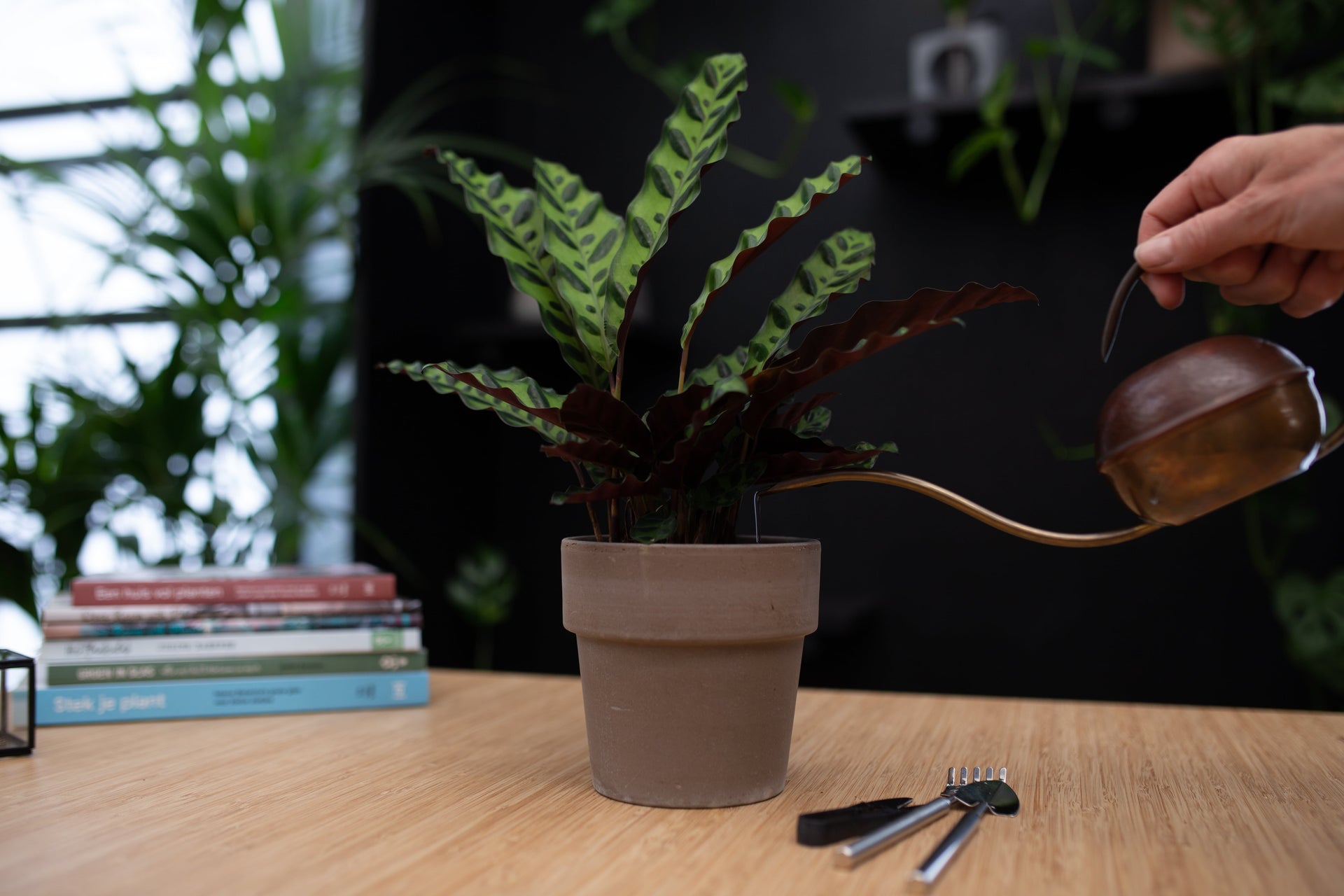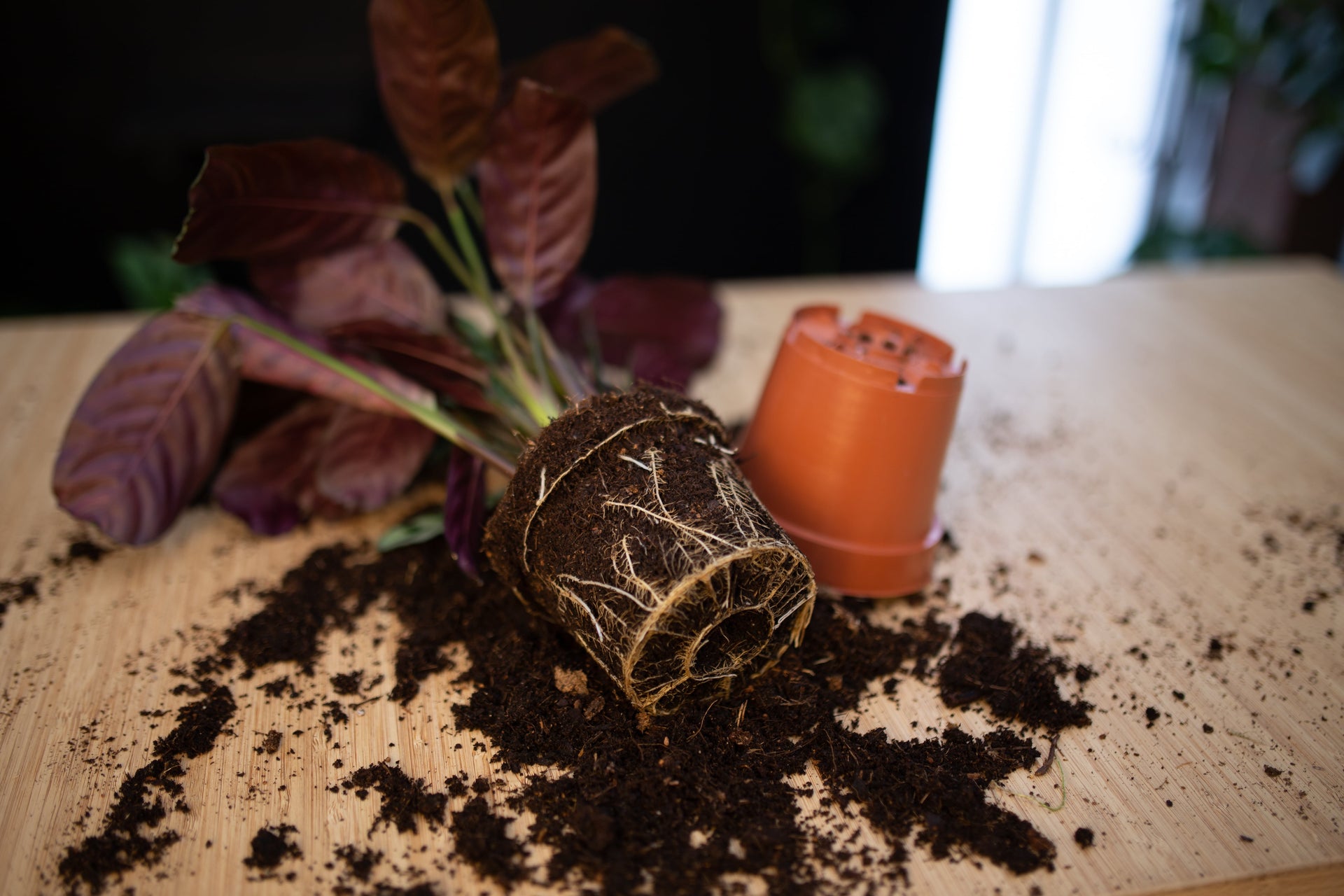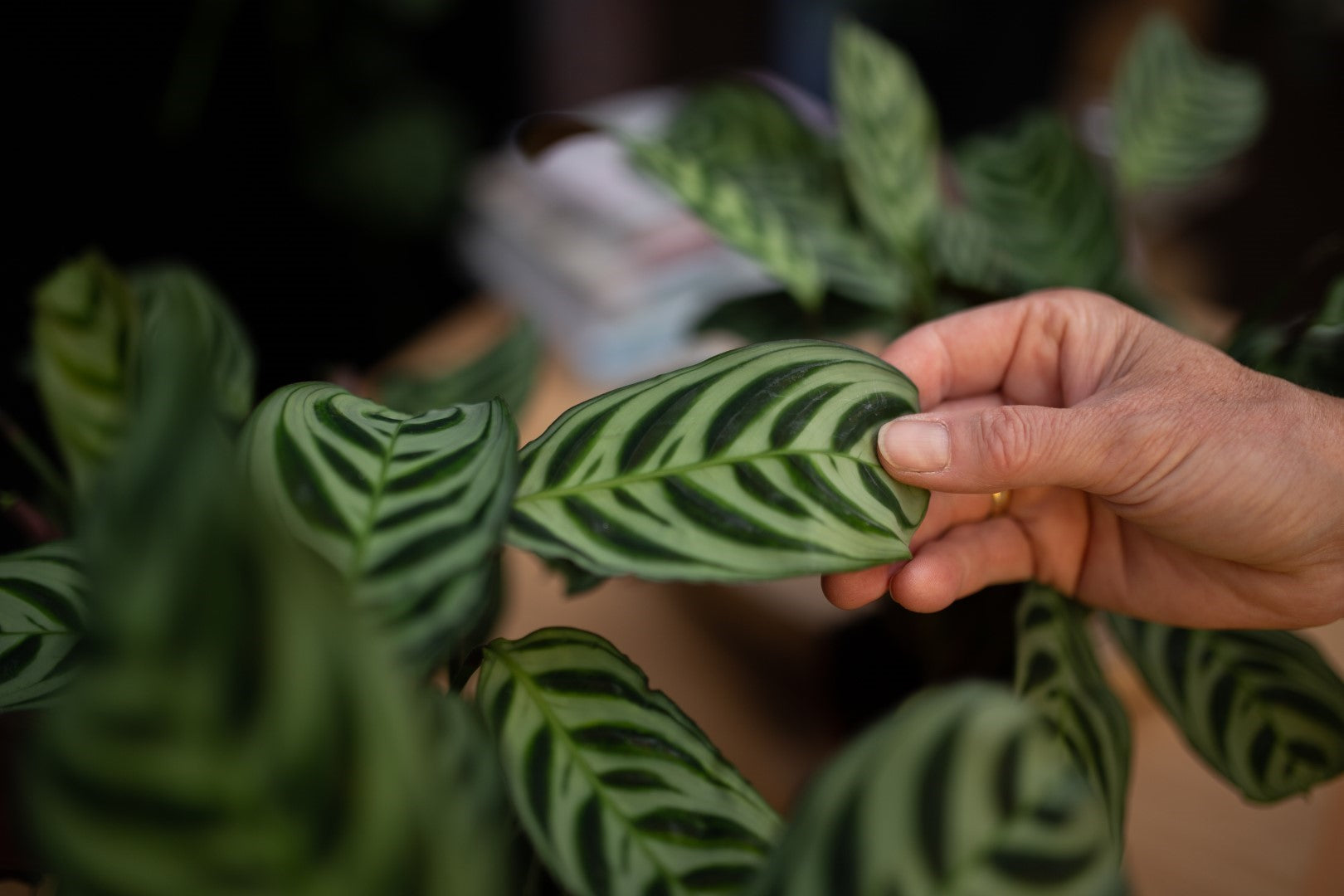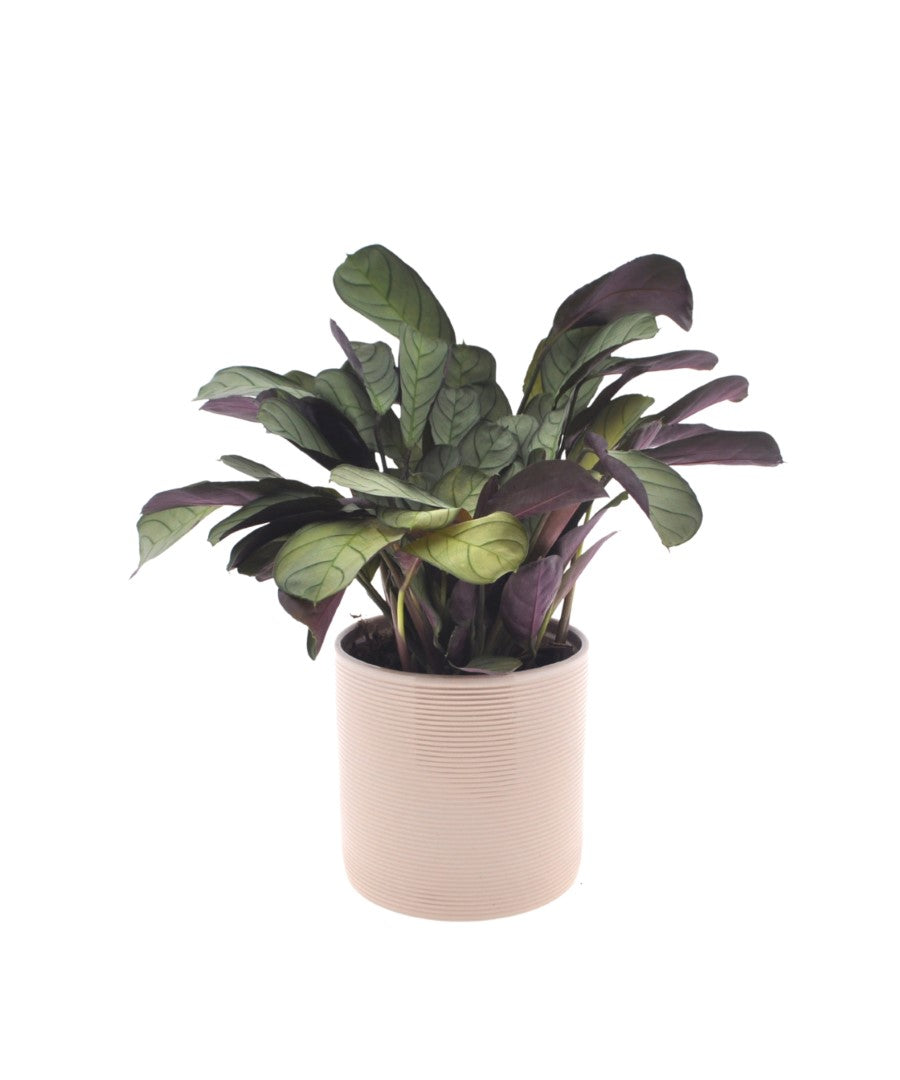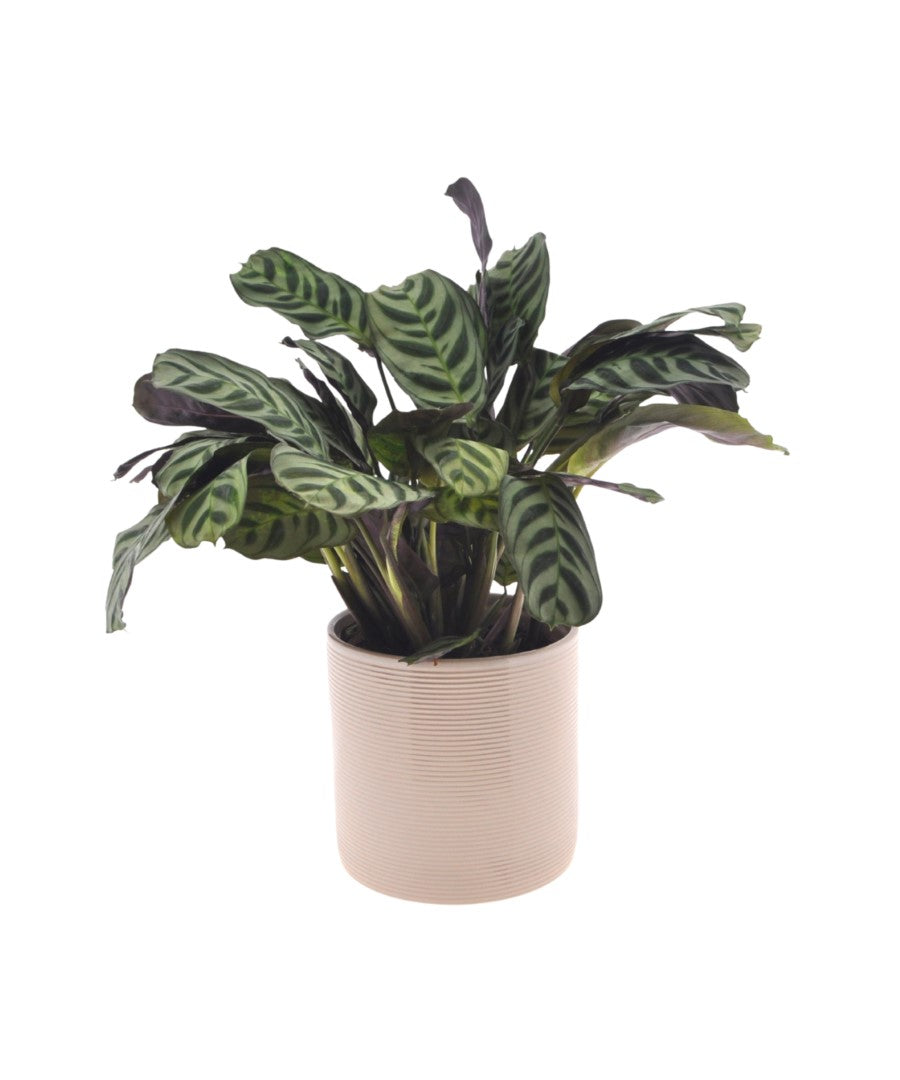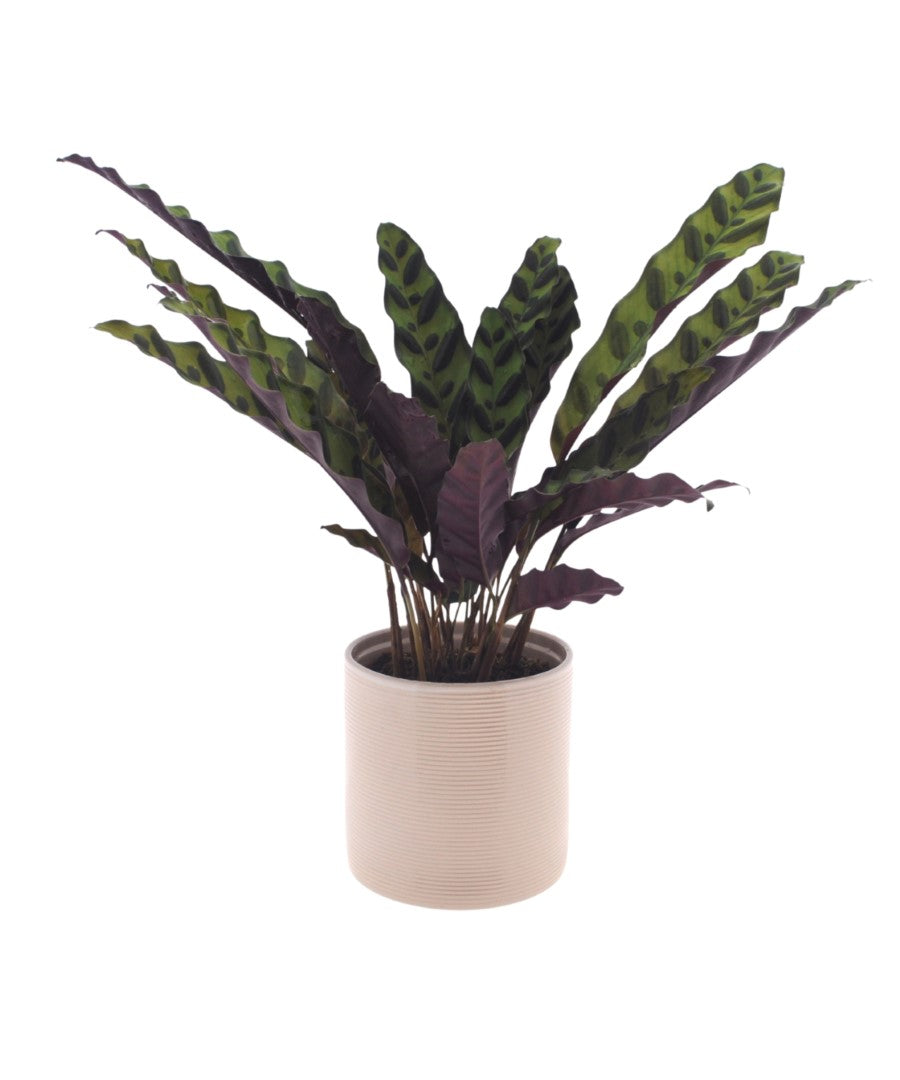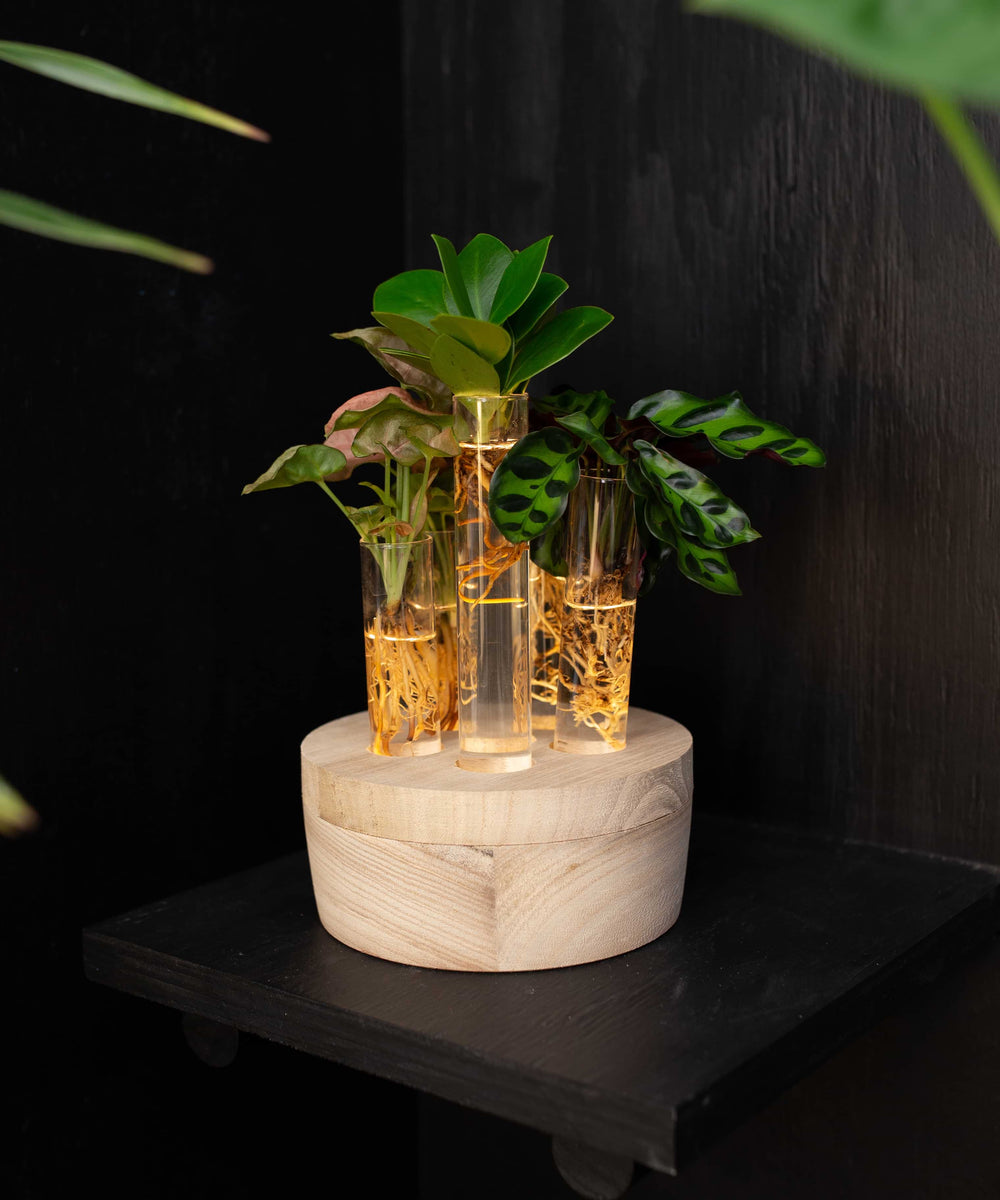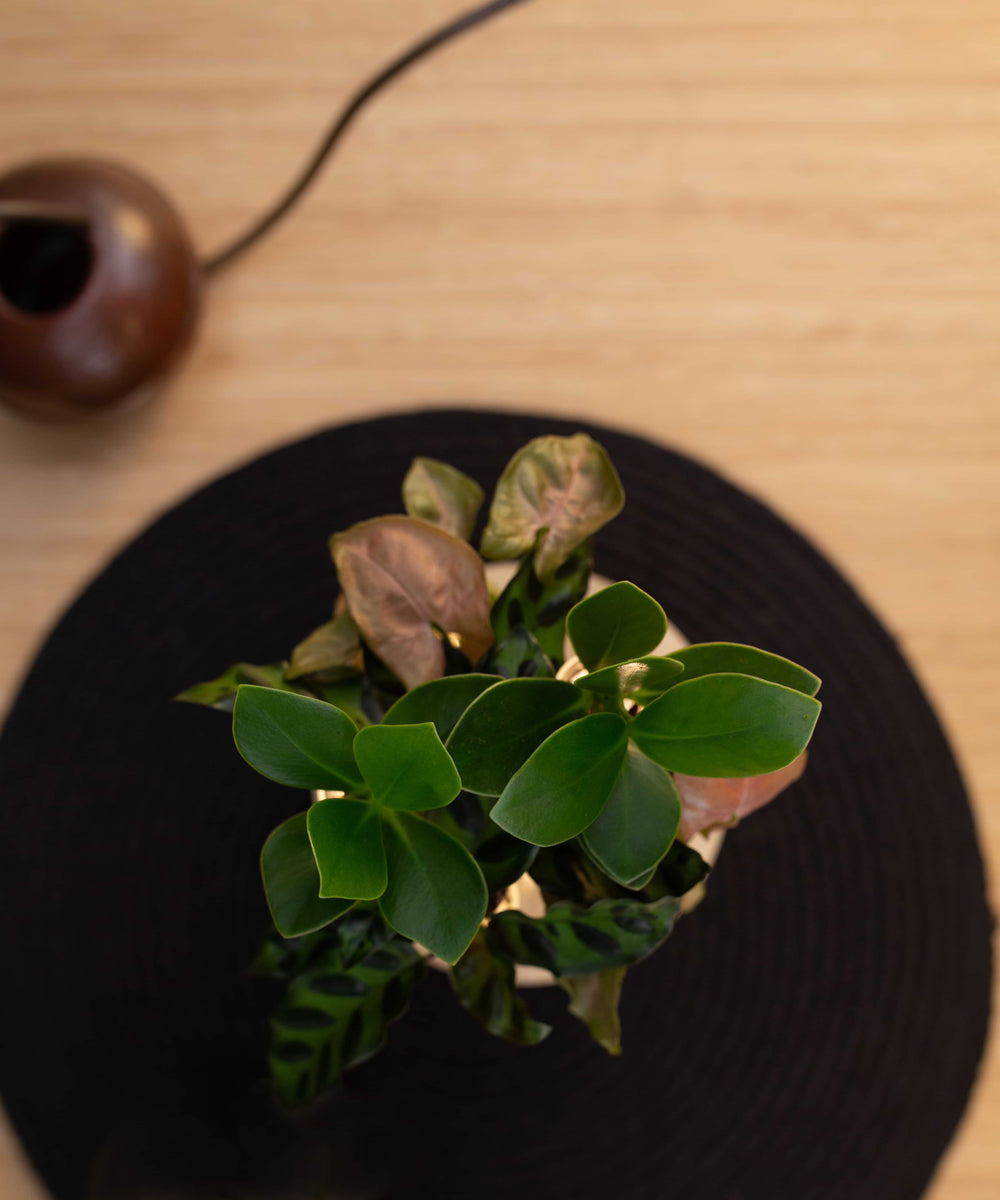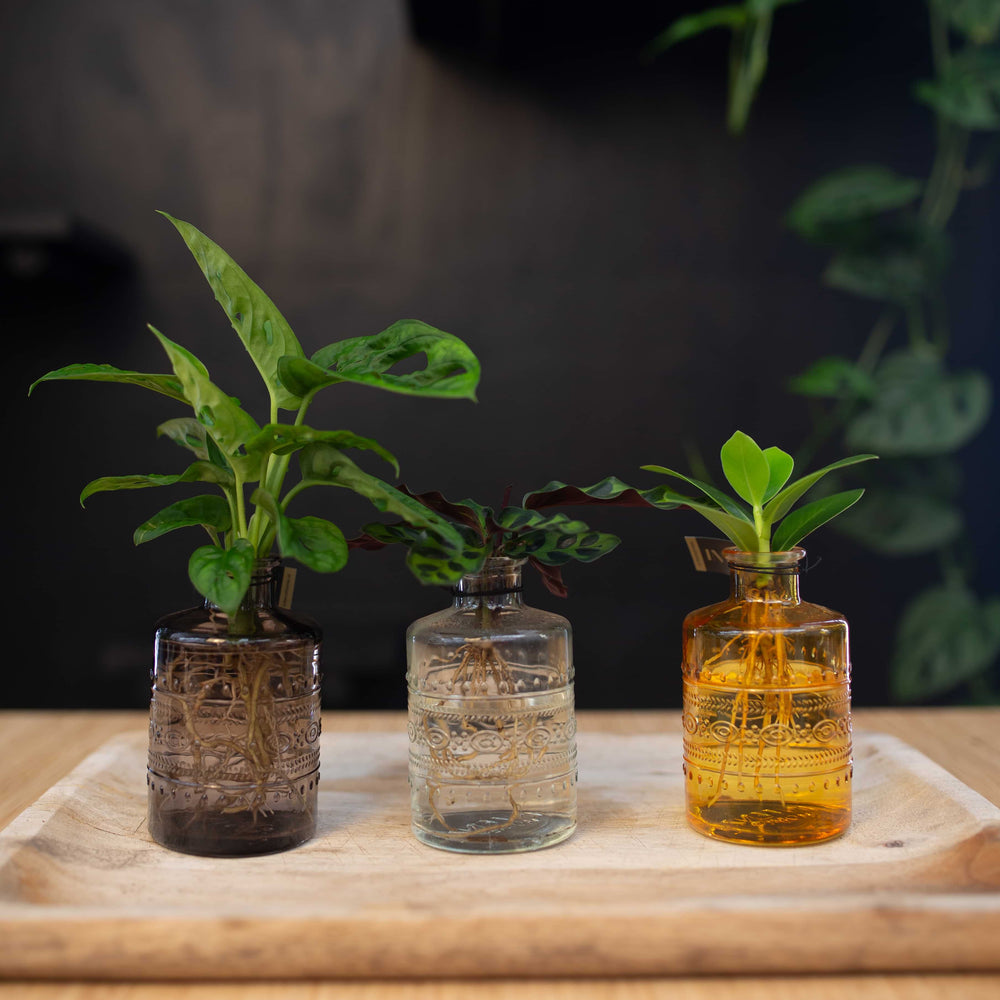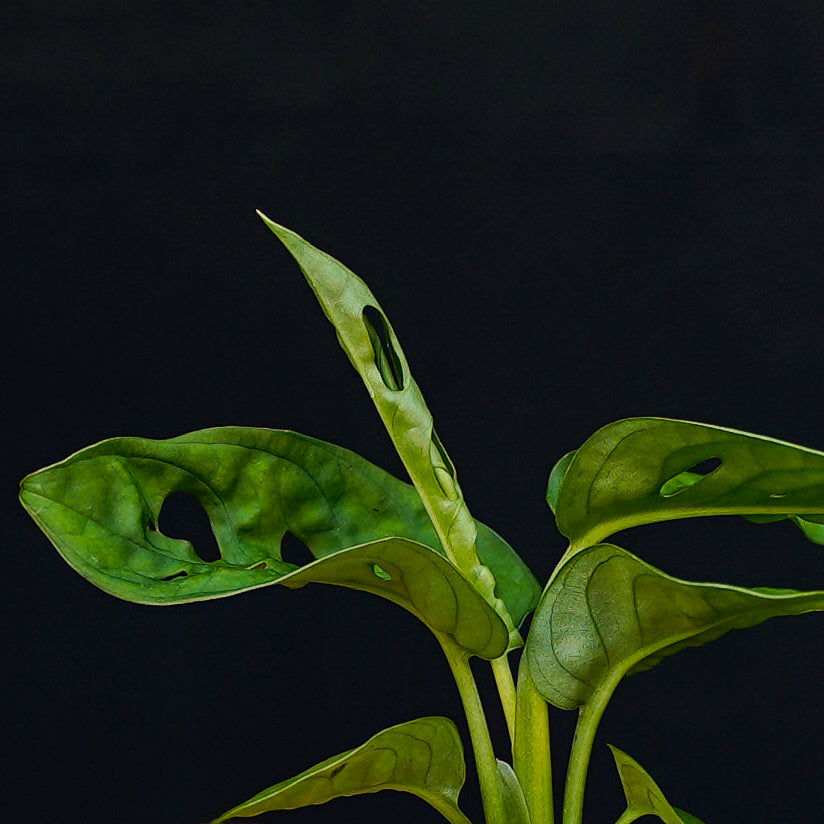Ontdek onze Calathea planten
Alles wat je wilt weten over de verzorging van je Calathea plant
Calathea-soorten zijn een prachtige toevoeging aan elke binnenruimte. Met hun betoverende bladpatronen en levendige kleuren brengen ze een vleugje schoonheid en natuurlijke elegantie in huis.
Het kiezen van de juiste locatie is essentieel voor de gezondheid van Calathea. Plaats ze op een plek met helder indirect licht en vermijd direct zonlicht.
Een warme omgeving met een gemiddelde temperatuur tussen 18°C en 24°C is ideaal.
Zorg ervoor dat de grond licht vochtig is. Vermijd drassige omstandigheden om wortelrot te voorkomen. Water geven is meestal nodig ongeveer één keer per week.
Verpot Calathea regelmatig in een pot die iets groter is dan de huidige pot. Doe dit in het voorjaar en gebruik verse potgrond.
Geef Calathea tijdens het groeiseizoen de juiste voeding. Stop met bemesten tijdens de wintermaanden.
Bladverkleuring kan worden veroorzaakt door te veel water, te veel zonlicht of onvoldoende water. Pas de omstandigheden aan om het probleem op te lossen.
Er zijn verschillende soorten Calathea om uit te kiezen, elk met zijn eigen unieke kenmerken en charme.
Calathea-soorten voegen schoonheid, elegantie en een ontspannen sfeer toe aan elk interieur.
Met deze verzorgingstips kun je ervoor zorgen dat jouw Calathea een gezonde plant blijft. Een natuurlijke pracht in jouw leefruimte.
Er zijn verschillende prachtige Calathea-soorten beschikbaar. Ze hebben allemaal hun eigen unieke kenmerken en betoverende bladpatronen. Hier zijn enkele populaire Calathea-soorten die je kunt overwegen:
Calathea Orbifolia. Deze soort staat bekend om zijn grote ronde bladeren met zilverachtige groene strepen. Het blad heeft een opvallend patroon en voegt een vleugje elegantie toe aan elke ruimte.
Calathea Insignis: Met zijn mooie en sierlijke bladtekeningen staat zij beter bekend als de Pauwenplant.
Ctenanthe Amagris. Ze staat bekend om haar grijs groen gekleurde bladeren met donkergroene strepen en een aubergine kleurige binnenkant.
Ctenanthe Burle Marxii: Ook bekend onder de naam de gebedsplant. Deze plant valt op door de bijzondere bladtekeningen en de verschillende bladkleuren.
Calathea Medallion. Deze soort heeft grote ronde bladeren met een donkergroen bladpatroon en een opvallende paarse onderkant. Het lijkt op een medaille, vandaar de naam “Medallion”.
Calathea Zebrina (Zebra plant). Deze soort onderscheidt zich door zijn opvallende strepen op het blad. Deze lijken op de strepen van een zebra. De bladeren hebben een combinatie van groene en paarse tinten, waardoor het een echte blikvanger is.
Calathea Roseopicta (Rose painted Calathea). Deze soort heeft prachtige bladeren met een uniek patroon van roze, groen en crèmekleurige strepen. Het geeft een vleugje kleur aan elke ruimte en is geliefd om zijn visuele aantrekkingskracht.
De plantensoorten Calathea en Ctenanthe worden vaak door elkaar gehaald qua uiterlijk. Dit komt omdat beide soorten heel bijzondere bladtekeningen hebben.
Beide plant soorten worden ‘never never plant’ of bidplant genoemd, dat betekent dat de bladeren dicht gaan staan in de avond en ‘s ochtends weer open gaan staan. Overdag is de mooie bladtekening van de bovenkant van de bladeren zichtbaar en als het donker wordt de paarse onderkant.
Het verschil is dat het blad van de Ctenanthe een stuk kleiner is, maar ook de grootte van de plant is veel kleiner dan de Calathea.
De opbouw is ook anders. Een Ctenanthe ontwikkelt bovengrondse vertakkende stengels, waar de Calathea alleen vanuit het hart van de plant nieuwe bladeren aanmaakt.
Tot slot is de Ctenanthe wat makkelijker te verzorgen dan de Calathea.
De verzorgingstips op deze pagina zijn van toepassing op zowel de Calathea als de Ctenanthe.
De juiste plaatsing van je Calathea is van groot belang. Deze plant gedijt het beste op een locatie met helder en indirect licht. Direct zonlicht kan de bladeren beschadigen en leiden tot verkleuring.
Kies daarom een plek in de buurt van een raam op het noorden, oosten of westen. Op die manier kan de plant genieten van het zachte ochtend- of avondlicht.
Daarnaast is het belangrijk om te weten dat de Calathea houdt van warmte. Een gemiddelde temperatuur tussen de 18°C en 24°C is ideaal voor deze tropische schoonheid. Zorg er echter voor dat de plant niet blootgesteld wordt aan tocht. Dit kan de groei belemmeren.
Een goede watergift is essentieel voor de gezondheid van je Calathea. Hier zijn enkele belangrijke punten om in gedachten te houden:
Houd de grond licht vochtig, maar niet nat. Overmatig water geven kan leiden tot wortelrot. Te weinig water resulteert in droge en slappe bladeren. Vind de juiste balans waarbij de grond licht vochtig aanvoelt. Meestal is dat één keer per week water geven.
Controleer de droogte van de grond om te bepalen wanneer je Calathea water nodig heeft. Steek je vinger ongeveer 2-3 centimeter diep in de grond. Als de grond op die diepte droog aanvoelt is het tijd om water te geven. Wacht dus nog even als de grond vochtig is.
Zorg ervoor dat de pot waarin je Calathea groeit drainage gaten heeft. Dit voorkomt dat overtollig water in de pot blijft staan en de wortels verstikt. Plaats een schotel onder de pot om het overtollige water op te vangen. Giet het water weg nadat de plant voldoende tijd heeft gehad om het op te nemen.
Het verpotten van de Calathea is een belangrijk onderdeel van de verzorging. Hier zijn enkele richtlijnen om te volgen:
Verpot je Calathea eens in de 1 tot 2 jaar, bij voorkeur in het voorjaar. Een grotere pot geeft de wortels meer ruimte om te groeien. Dat bevordert een gezonde ontwikkeling van de plant.
Kies een pot die iets groter is dan de vorige, maar niet te groot. Een pot die te groot is kan leiden tot wateroverlast en langzamere groei.
Gebruik een goed doorlatende potgrond die rijk is aan organisch materiaal. Dit helpt bij een goede lucht- en vochtcirculatie rond de wortels.
Zorg ervoor dat de plant op dezelfde diepte wordt geplaatst als in de vorige pot. Bedek de wortels met verse potgrond en druk zachtjes aan om luchtbellen te vermijden.
Geef de plant na het verpotten een goede watergift om de wortels te helpen settelen. Zo past hij zich aan de nieuwe omgeving.
Zowel de Calathea als de Ctenanthe maken onder de grond nieuwe scheuten. Die scheuten worden ook wel wortel stokken genoemd. De plant word voller naarmate hij ouder wordt.
Je kan heel eenvoudig (maar voorzichtig) zo’n scheut afsnijden en in een nieuwe pot poten zodat hij uitgroeit tot een nieuwe plant. Let er wel op dat de scheut een goede wortel heeft zodat hij krachtig genoeg is om verder door te groeien.
De stek hieronder op de foto heeft één hoofdtak met 2 nieuwe scheuten. Zet je hem in een pot zal hij dus al snel drie scheuten hebben en voller worden.
In huis is het echter kouder dan in de kas waar de Calathea opgroeit. Hierdoor duurt het langer voordat de plant vol zal zijn.
Dit kan duiden op een lage luchtvochtigheid. Probeer de luchtvochtigheid rond de plant te verhogen. Dat kan met een luchtbevochtiger of een bakje water in de buurt van de plant. Vermijd ook direct contact met een koude tocht.
Gele bladeren kunnen het gevolg zijn van overwatering, blootstelling aan direct zonlicht of voedingsproblemen. Controleer je watergeef routine. Verplaats de plant naar een geschikte locatie en zorg ervoor dat je de juiste hoeveelheid voeding geeft.
Calathea’s kunnen gevoelig zijn voor plagen zoals spintmijten en bladluizen. Gebruik een duurzame milde insecticide om de plagen te bestrijden. Zorg voor een goede luchtstroom rond de plant om ze te ontmoedigen.
De Calathea is geen hongerige plant, maar het geven van voeding zal de groei en gezondheid bevorderen. Hier zijn enkele tips voor het voeden van je Calathea:
Gebruik een gebalanceerde vloeibare voeding die specifiek is samengesteld voor bladplanten.
Volg de instructies op de verpakking om de juiste hoeveelheid meststof te doseren. Overbemesting kan schadelijk zijn voor de plant. Wees dus voorzichtig en houd je aan de aanbevolen dosering.
Voed je Calathea tijdens het groeiseizoen. Dat begint in het voorjaar en loopt tot de zomer. Stop met het geven van voeding in de herfst en winter. De plant is in die periode meestal in rust.
